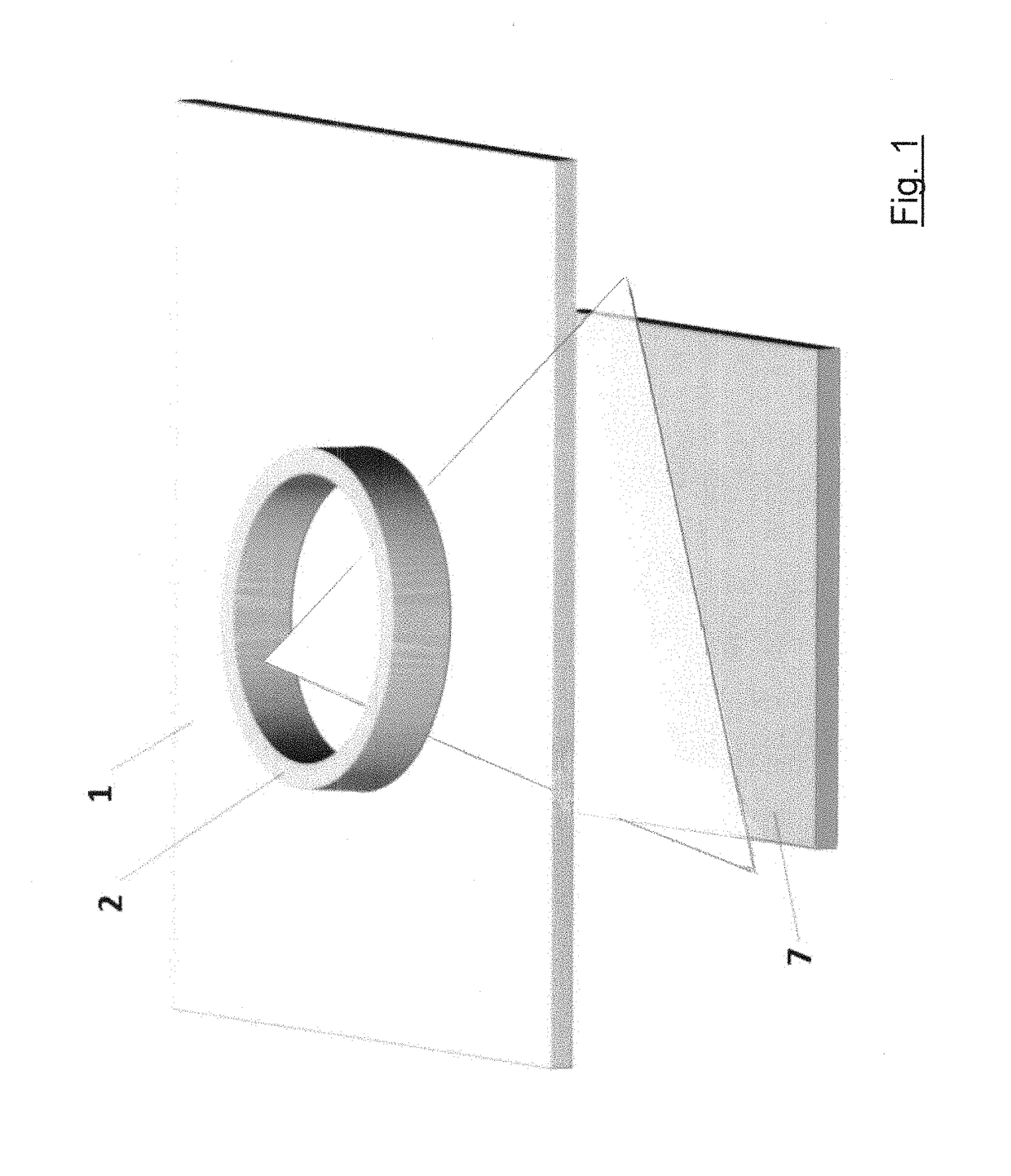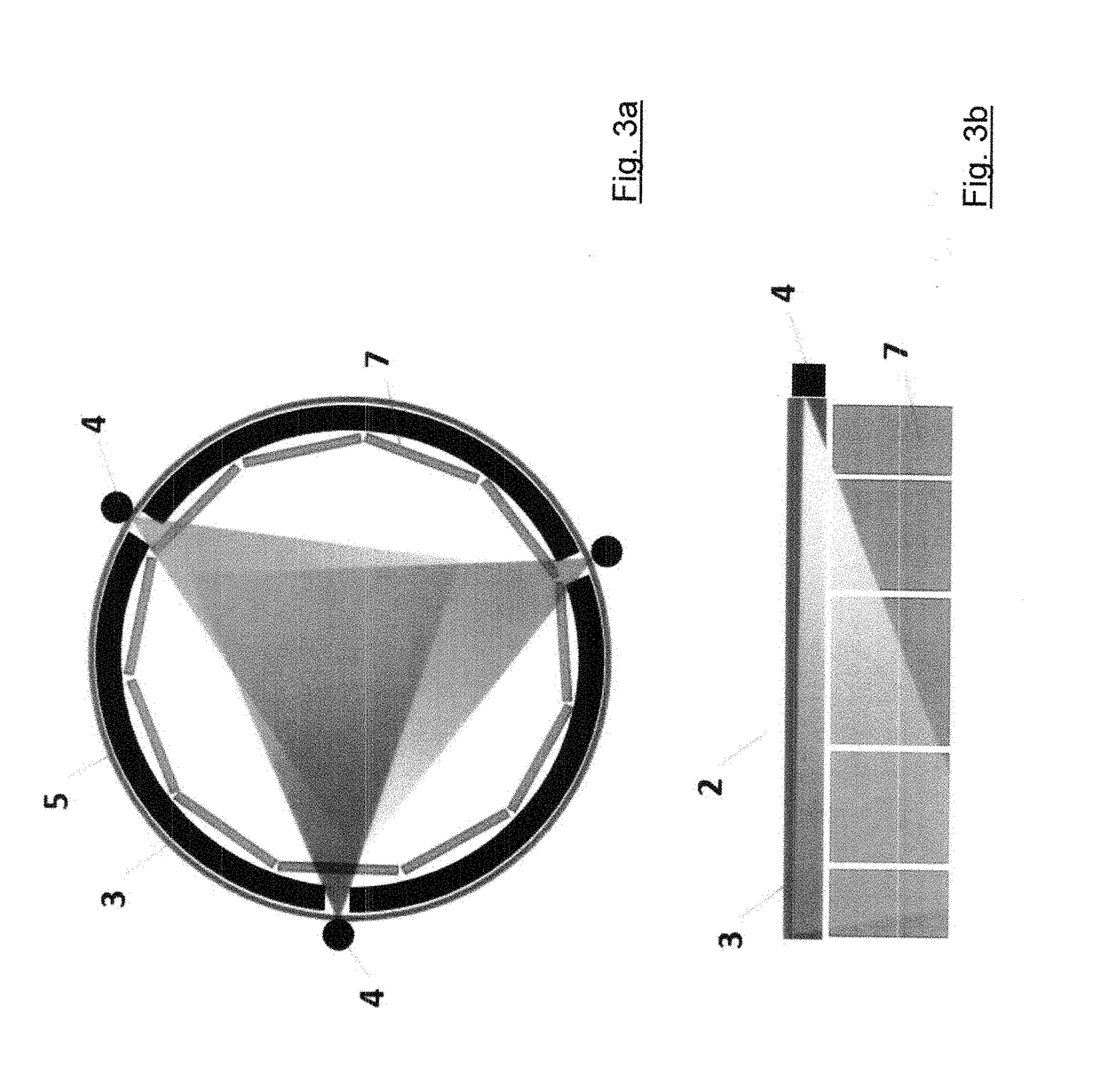Circular x-ray tube and an x-ray instrument comprising the circular x-ray tube
a technology of circular x-ray tube and x-ray instrument, which is applied in the direction of x-ray tubes, x-ray tubes with very high current, x-ray tubes, etc., can solve the problems of in-situ deployment of such x-ray tubes, x-ray tubes must be connected to a source of high electric voltage, and reduce the legibility of images, and the effect of negative impact on the x-ray scanning of objects
- Summary
- Abstract
- Description
- Claims
- Application Information
AI Technical Summary
Benefits of technology
Problems solved by technology
Method used
Image
Examples
example 1
[0050]FIG. 1 shows a schematic diagram of an example of the application of the X-ray instrument with the circular X-ray tube that can be used for X-ray laminography. The planar irradiated object 1, for example a composite plate, is positioned under the circular X-ray tube, of which only the circular body 2 is visible in the schematic diagram. The circular X-ray tube emits an X-ray beam striking upon the irradiated object 1. Under the object 1, an imaging detector 7 of ionizing radiation, whose impact detection surface is struck upon by the X-ray beam penetrating the object 1, is provided. The imaging detector 7 can be, for example, the model known under the TimePix brand.
[0051]The X-ray beam is gradually radiated within the full range of 360°, allowed by the circular X-ray tube, which results in the X-radiation passage through the exposed part of the irradiated object 1. The result of X-ray laminography is evaluated from a set of acquired images in a way known to a person skilled in...
example 2
[0052]FIG. 2a and FIG. 2b provide a schematic diagram of an example of the embodiment of the X-ray instrument with the circular X-ray tube with an unshielded X-ray beam. For better clarity of the figures, the circular body 2 is not provided. The circumferential element 3, comprised by e.g. a piece of plastic material, is supported by the circular body 2, or, where applicable, is integrated in the circular body 2. One pressure element 4 manufactured from e.g. tungsten is dragged upon the circumferential element 3. Eleven detectors 7 form a polygonal circular detection field without gaps that allows, with the rotating pressure element 4, eleven direct X-ray images per one revolution of the circular body 2 to be acquired. The detection field is arranged under the space delimited by the circular body 2, as shown in FIG. 2b. The detectors 7 can be tilted with regard to the X-ray beam to improve the X-radiation incidence onto their impact detection surface.
[0053]In a modified Example 2, n...
example 3
[0054]FIG. 3a and FIG. 3b provide a schematic diagram of an example of the embodiment of the X-ray instrument with the circular X-ray tube with an X-ray beam collimated by a shield 5. For better clarity of the figures, the circular body 2 is not provided but only the shield 5 is provided in the figure. The shield 5 is comprised of for example lead. The schematic diagram shows three openings in the shield 5 that collimate X-ray beams from three neighbouring pressure elements 4. The pressure elements 4 have regular distances from one another. The detectors 7 are employed similarly as in Example 2.
[0055]The shield 5 rotates together with the rotating pressure elements 4, so that the openings in the shield 5 correspond with the pressure elements 4. The collimation of X-ray beams eliminates X-ray image distortion.
PUM
 Login to View More
Login to View More Abstract
Description
Claims
Application Information
 Login to View More
Login to View More - R&D
- Intellectual Property
- Life Sciences
- Materials
- Tech Scout
- Unparalleled Data Quality
- Higher Quality Content
- 60% Fewer Hallucinations
Browse by: Latest US Patents, China's latest patents, Technical Efficacy Thesaurus, Application Domain, Technology Topic, Popular Technical Reports.
© 2025 PatSnap. All rights reserved.Legal|Privacy policy|Modern Slavery Act Transparency Statement|Sitemap|About US| Contact US: help@patsnap.com



